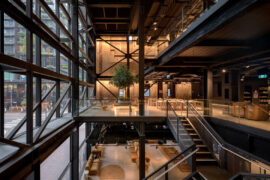Have we failed to provide equal access and equal opportunity for the disabled community? Where can A+D improve?

Photography: Emily Morter
Architecture and design have an inherent relationship with disability. However, despite legislation in place to mandate equal access within our shared built environment, the history of A&D has often been a discriminating one. The able-bodied end user has more often than not been the human model to design towards, evident in Le Corbusier’s “Modulor Man” or Frank Lloyd Wright purportedly using his own height as basis for doorway and ceiling heights. Understanding the proportions of the human body is certainly valuable, but fails to take into account the sheer variation possible in human form – disabled or not.
Today we might laugh at stories of conversations between clients and the stubborn Mr Wright. However, while the relationship between architecture and disability has certainly come a long way from being a private problem to a public issue since the times of those two architectural giants, there is still a ways to go when it comes to complete recognition.
One study undertaken in 1991 from schools of architecture in the United States revealed that students had “limited knowledge on disability and accessibility provision.” Furthermore, while a few students defined disability as including wheelchair users, children, people with prams, pregnant women and others, most of the students defined disabled people solely as wheelchair users. While true, this is evidence of a continual inadvertent discrimination against many of those with disabilities that aren’t physically evident. A similar study conducted around architects in Istanbul revealed that physical disability generally was prioritised when considering design problems.
Invisible disabilities, such as vision impairment, chronic pain or a host of mental illnesses may not be readily evident, and nor do they hold solutions that will necessarily come immediately. However, they still have the potential to be assisted through a design-centric approach, as explored by Sydney University’s 2016 “Enabled by Design-athon”, which aimed to “mastermind new products and technology that could help improve the lives of people living with a disability.” A more widespread acceptance of such an approach may require a shift in mindset from education up, given the tendency to see the consideration of disability as currently being another requirement legislated by the BCA in the same vein as door heights and stair tread lengths.
Questioning what really entails a ‘typical’ user, as academic Jos Boys writes, might lead to more innovative design solutions that don’t attempt to “solve” the problem of disability, but rather simply take into account “how diverse human bodies actually occupy space.” Design solutions need not be overly complicated or one-off opportunities to explore something crazy, like OMA’s Maison Bordeaux. Rather, the A+D community is undoubtedly better off “confronting the ordinary” and making disability less of a taboo issue for everyone as a result.
This article is proudly presented in collaboration with Interface, thought-leaders in this sector.
INDESIGN is on instagram
Follow @indesignlive
A searchable and comprehensive guide for specifying leading products and their suppliers
Keep up to date with the latest and greatest from our industry BFF's!

The undeniable thread connecting Herman Miller and Knoll’s design legacies across the decades now finds its profound physical embodiment at MillerKnoll’s new Design Yard Archives.

London-based design duo Raw Edges have joined forces with Established & Sons and Tongue & Groove to introduce Wall to Wall – a hand-stained, “living collection” that transforms parquet flooring into a canvas of colour, pattern, and possibility.

For Aidan Mawhinney, the secret ingredient to Living Edge’s success “comes down to people, product and place.” As the brand celebrates a significant 25-year milestone, it’s that commitment to authentic, sustainable design – and the people behind it all – that continues to anchor its legacy.

QIP recently held a significant event in Sydney, bringing together LGBTQI+ people across the property and construction industry.

The Sustainability Summit panel delves into innovative models such as the Nightingale Housing model and the AssembleFutures concept.
The internet never sleeps! Here's the stuff you might have missed

MillerKnoll reimagines the convention of dinner table interactions by plating up a future-forward menu of sustainable design conversation starters as part of the inspiring “Conversations for a Better World” event series.

Tzannes has completed work at The Brewery in Sydney’s Central Park, marking the culmination of an internationally significant adaptive reuse project.

Grounded by the rich warmth of American white oak, The Standard’s newly opened restaurant, Kaya, redefines the classic dining convention through a tasteful fusion of biophilic design, mid-century modern sensibility and elevated whimsy.

Adam Markowitz Design, in collaboration with Simeon Dux, has been awarded The Object at the INDE.Awards 2025. Their winning project, A Cabinet of Curiosities, is a masterwork of craftsmanship and adaptability; a poetic response to shifting domestic and professional life in the post-COVID era.